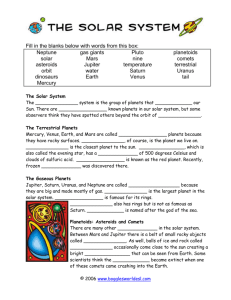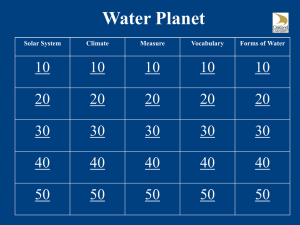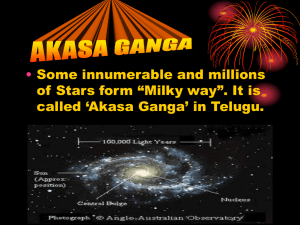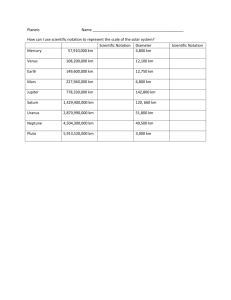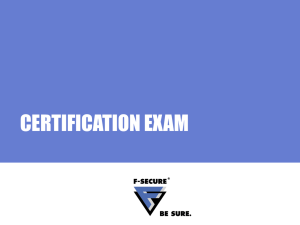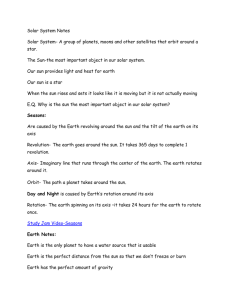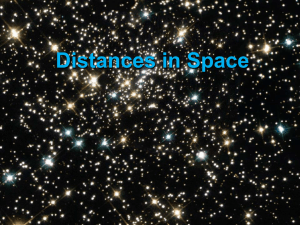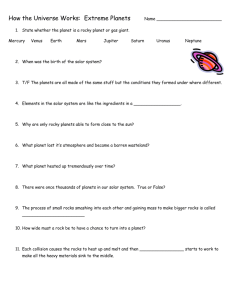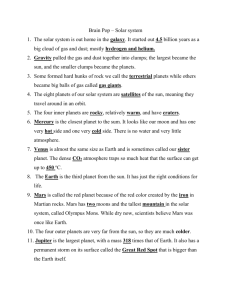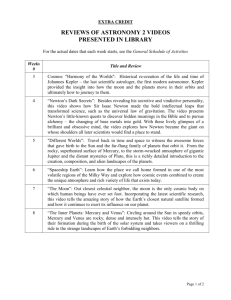Solar System: Planets and Moon Size and
advertisement
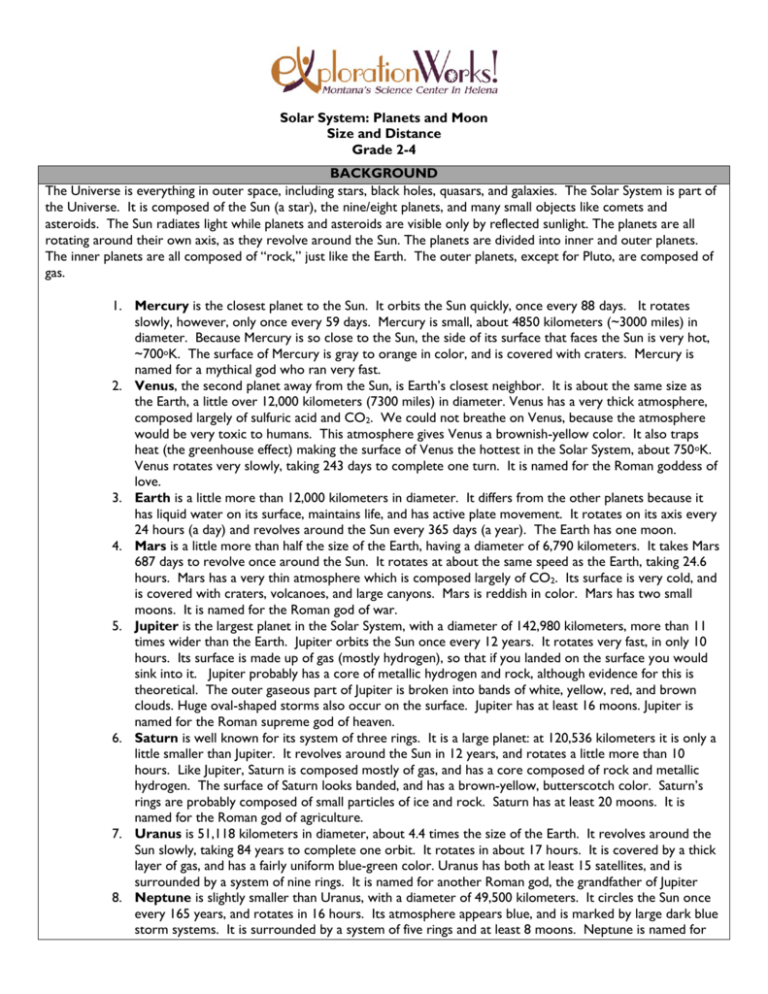
Solar System: Planets and Moon Size and Distance Grade 2-4 BACKGROUND The Universe is everything in outer space, including stars, black holes, quasars, and galaxies. The Solar System is part of the Universe. It is composed of the Sun (a star), the nine/eight planets, and many small objects like comets and asteroids. The Sun radiates light while planets and asteroids are visible only by reflected sunlight. The planets are all rotating around their own axis, as they revolve around the Sun. The planets are divided into inner and outer planets. The inner planets are all composed of “rock,” just like the Earth. The outer planets, except for Pluto, are composed of gas. 1. Mercury is the closest planet to the Sun. It orbits the Sun quickly, once every 88 days. It rotates slowly, however, only once every 59 days. Mercury is small, about 4850 kilometers (~3000 miles) in diameter. Because Mercury is so close to the Sun, the side of its surface that faces the Sun is very hot, ~700oK. The surface of Mercury is gray to orange in color, and is covered with craters. Mercury is named for a mythical god who ran very fast. 2. Venus, the second planet away from the Sun, is Earth’s closest neighbor. It is about the same size as the Earth, a little over 12,000 kilometers (7300 miles) in diameter. Venus has a very thick atmosphere, composed largely of sulfuric acid and CO2. We could not breathe on Venus, because the atmosphere would be very toxic to humans. This atmosphere gives Venus a brownish-yellow color. It also traps heat (the greenhouse effect) making the surface of Venus the hottest in the Solar System, about 750 oK. Venus rotates very slowly, taking 243 days to complete one turn. It is named for the Roman goddess of love. 3. Earth is a little more than 12,000 kilometers in diameter. It differs from the other planets because it has liquid water on its surface, maintains life, and has active plate movement. It rotates on its axis every 24 hours (a day) and revolves around the Sun every 365 days (a year). The Earth has one moon. 4. Mars is a little more than half the size of the Earth, having a diameter of 6,790 kilometers. It takes Mars 687 days to revolve once around the Sun. It rotates at about the same speed as the Earth, taking 24.6 hours. Mars has a very thin atmosphere which is composed largely of CO2. Its surface is very cold, and is covered with craters, volcanoes, and large canyons. Mars is reddish in color. Mars has two small moons. It is named for the Roman god of war. 5. Jupiter is the largest planet in the Solar System, with a diameter of 142,980 kilometers, more than 11 times wider than the Earth. Jupiter orbits the Sun once every 12 years. It rotates very fast, in only 10 hours. Its surface is made up of gas (mostly hydrogen), so that if you landed on the surface you would sink into it. Jupiter probably has a core of metallic hydrogen and rock, although evidence for this is theoretical. The outer gaseous part of Jupiter is broken into bands of white, yellow, red, and brown clouds. Huge oval-shaped storms also occur on the surface. Jupiter has at least 16 moons. Jupiter is named for the Roman supreme god of heaven. 6. Saturn is well known for its system of three rings. It is a large planet: at 120,536 kilometers it is only a little smaller than Jupiter. It revolves around the Sun in 12 years, and rotates a little more than 10 hours. Like Jupiter, Saturn is composed mostly of gas, and has a core composed of rock and metallic hydrogen. The surface of Saturn looks banded, and has a brown-yellow, butterscotch color. Saturn’s rings are probably composed of small particles of ice and rock. Saturn has at least 20 moons. It is named for the Roman god of agriculture. 7. Uranus is 51,118 kilometers in diameter, about 4.4 times the size of the Earth. It revolves around the Sun slowly, taking 84 years to complete one orbit. It rotates in about 17 hours. It is covered by a thick layer of gas, and has a fairly uniform blue-green color. Uranus has both at least 15 satellites, and is surrounded by a system of nine rings. It is named for another Roman god, the grandfather of Jupiter 8. Neptune is slightly smaller than Uranus, with a diameter of 49,500 kilometers. It circles the Sun once every 165 years, and rotates in 16 hours. Its atmosphere appears blue, and is marked by large dark blue storm systems. It is surrounded by a system of five rings and at least 8 moons. Neptune is named for the Roman god of the ocean. 9. Pluto is the most distant planet from the Sun. It has an eccentric, oval-shaped orbit, which is tilted with respect to the rest of the Solar System. Pluto revolves around the Sun in 248 years, and rotates in a period of 6.4 days. Pluto is probably composed of rock. Its surface and color are unknown. It has one large moon. Pluto is named for the Roman god of outer darkness. Ever since the discovery of Pluto in 1930, kids grew up learning about the nine planets of our solar system. That all changed starting in the late 1990s, when astronomers began to argue about whether Pluto was a planet. In a highly controversial decision, the International Astronomical Union ultimately decided in 2006 to call Pluto a “dwarf planet,” reducing the list of “real planets” in our solar system to eight. But many kids (and adults) cling to the notion of nine planets. Regardless of your view, here’s the order of the eight larger planets, starting nearest the sun and working outward through the solar system: Mercury, Venus, Earth, Mars, Jupiter, Saturn, Uranus, Neptune. Star - is a massive, luminous sphere of plasma held together by its own gravity. Provides energy for its system. Planet - is an astronomical object orbiting a star. Moon – is a small object orbiting a planet. Orbit - is a curved path of an object around a point in space. The planets move around the Sun. This motion is called revolution. Each of the planets also spins around an internal axis which is called rotation. Although these are simple concepts, our language sometimes uses these words differently. For example, revolving sometime is used to mean an object turning on itself, like a revolving door; this is actually rotation. This makes the astronomical use of these terms confusing for students. All the planets spin in the same direction as Earth (counterclockwise), except Venus, Uranus, and Pluto, which spin backward. BASIC LESSON Objective(s) Students will be able to… Recognize that planets can have moons Identify the planets in our solar system State Science Content Standard(s) 4.6. Identify objects (e.g., moon, stars, meteors) in the sky and their patterns of movement and explain that light and heat comes from a star called the sun 1.4 Use models that illustrate simple concepts and compare those models to the actual phenomenon Materials Safety From the Kit Provided by Teacher [List any safety PLANETS – A Solar System Internet or resources for research project precautions Stickerbook by Ellen Paper for planet posters – uniform size here] Hasbrouck Giant Magnetic Solar System Earth Globe Orrery (Solar System Model) EVALUATION – Our Solar System – binder or website Key Vocabulary Mastery Questions Planets See Lesson Sun Star Moon Mercury, Venus, Earth, Mars Jupiter, Saturn, Uranus, Neptune Pluto Dwarf Planet Detailed Plan Lesson 1: Planets of the Solar System – Research Project Engage Ask “ Who can show me where the Sun is? Is it hot or cold? Who can tell me about their favorite planet? What does it look like?” Read to the class “PLANETS – A Solar System Stickerbook”. As you go through the book, ask the students what they think the next planet is then read the information to them. As you do this you can place the magnetic planets on the whiteboard in proper order and label them. (Be sure to tell them the sizes and distances are NOT relatively correct – just the order and picture are correct.) After the poem featured in the sun is a “Did You Know?” section. Ask the students what they know about each section. What do you know about the universe? What is it made up of? What is in the solar system? What are asteroids? What is a meteoroid? What do you know about the Sun? and so on……. On the back inside cover is the definition of revolution and rotation. Ask the students if they know the difference. What is a revolution of a planet measure? What does a rotation of a planet measure? Use the Orerry Model to demonstrate the revolution of planets and the globe to demonstrate rotation. There is a lesson on rotation and revolution in the K-2 lesson found in this kit. Exploration/Explanation Now divide students into eleven small groups: one for each of the eight planets, one for Pluto, one for the Moon, and one for the Sun. (Add asteroids and comets if you would to cover them.) Have each small group research a few facts about their solar system object and then create a colorful poster for the classroom wall that displays the results of the group research. The color on the poster should reflect the actual appearance of the planet. See figure 1.1 for an example. Figure 1.1. Shown here are examples of two possible solar system posters that students might create. Note that some of the answers students provide may not be strictly correct. For example, it is the Mare (large impact basins), not the craters, that creates the impression of the “Man in the Moon”. Suggested information for the students to research are: Size (diameter) Number of moons Number of rings Length of rotation Length of revolution (orbit year) Location in the solar system Appearance Composition Origin of name Distance from the sun Physical features – craters, temperature, gas or a solid, rings Number of moons Unique fact about the topic After completing the research and constructing the poster, have the students share information with the entire class. Posters may be displayed after report. If you are going to evaluate them by testing at the end of the activity, tell them they need to listen to their classmates’ information because it may be on a test. The reports may be used later for the advanced lesson. To help students memorize the names of the planets and their positions in the solar system try this device: My (Mercury) Very (Venus) Excited (Earth) Mother (Mars) Just (Jupiter) Served (Saturn) Us (Uranus) Nine (Neptune) Pizzas (Pluto) Assessment Evaluate the students work based on the quality and accuracy of the poster and the information on it. Evaluate the presentation. Research Report: My Planet Report (possible rubric) CATEGORY 4 3 2 1 Amount of Information All information is reported accurately. Five of the seven sentences are answered accurately. Three of the seven sentences are answered accurately. One of the seven sentences are answered accurately. Quality of Information Additional information clearly relates to the main topic. It includes several supporting details and/or examples. Some additional information clearly relates to the main topic. It provides one-two supporting details and/or examples. Little additional information clearly relates to the main topic. No details and/or examples are given. Information has little or nothing to do with the main topic. Mechanics No grammatical, Almost no spelling or grammatical, punctuation errors. spelling or punctuation errors A few grammatical Many grammatical, spelling, or spelling, or punctuation errors. punctuation errors. Internet Use Successfully used suggested internet links to find information and navigates within these sites easily without assistance. Occasionally able to use suggested Internet links to find information and navigates within these sites easily without assistance. Usually able to use suggested Internet links to find information and navigates within these sites easily without assistance. Needs assistance or supervision to use suggested internet links and/or to navigate within these sites. Found in the binder or website is a test for the planets correct position and information that may have been shared in the presentation. Students will have to listen to what their classmates share in order to get some of the questions correct. Resources Student-Friendly Web Sites: NASA Kids kids.msfc.nasa.gov/SolarSystem/ NASA’s Planetary Photojournal photojournal.jpl.nasa.gov Teacher-Oriented Web Sites: American Association for the Advancement of Science, Project 2061 Benchmarks www.project2061.org/tools/benchol/bolintro.htm Exploring Planets in the Classroom www.spacegrant.hawaii.edu/class_acts/ National Science Education Standards www.nap.edu/html/nses/ The Nine Planets www.nineplanets.org/ Voyage Online www.voyageonline.org/ ADVANCED LESSON Objective(s) Students will be able to… Identify the relative location and size of planets and the sun State Science Content Standard(s) 4.6. Identify objects (e.g., moon, stars, meteors) in the sky and their patterns of movement and explain that light and heat comes from a star called the sun 1.4 Use models that illustrate simple concepts and compare those models to the actual phenomenon Materials Safety Provided by Teacher None From the Kit Knotted cord Posters of planets from the basic lesson or pictures provided by the instructor. Giant pumpkin or Halloween pumpkin garbage bag Coffee bean Large blueberry Cherry Pea Large grapefruit or cantaloupe Very large orange Kiwi Apricot or nectarine Grain of rice Paper for drawing planets Compass or string Paints or color markers Key Vocabulary Planets Sun Solar system Moon Diameter/radius Orbit/revolution Rotation Detailed Plan Solar System Size and Distance of Planets 1.Solar System Dance Engage Review with students the order of the planets in the solar system using their posters from the report. Mastery Questions See Lesson Explanation/Exploration Explain to the students they are going to do the solar system dance to show the movement of the planets around the sun. Students can now use their completed posters or pictures provided by the instructor to help them perform a solar system dance. You may want each group to elect one student to represent their planet. Or you may want to do the dance two or three times so everyone has a chance to perform. Have the dancers arrange themselves as the planets around the Sun, and move in orbits around the Sun. Earth should spin on its axis as it orbits the Sun, and the Moon should orbit around Earth as Earth orbits around the sun. See picture below. If you wish to include the dwarf planet Pluto in your dance, the student representing this newly reclassified object will have to find a way to represent its unusual orbit. Standing up on a table in the farthest corner of the classroom would be a good approximation for Pluto. All the planets spin in the same direction as Earth (counterclockwise), except Venus, Uranus, and Pluto, which spin Clockwise. If this is too difficult just make sure the students are attempting to spin (rotate) as they orbit the sun. Ask them Do you think the models (orrery) or their solar system dance represent the correct distance between the planets? Does their poster represent the correct size of the planet in comparison to others? Are they too close or too far apart? What is the solar system made of mostly?(Space) What is similar about the planets? (All planets are spherical, spin on their axes, and orbit our Sun in the same direction). What are the main differences of the planets? (Some of these might be included: Because of their distance from our Sun, the surfaces of the inner planets are warmer than the outer planets. Five planets are solid and four — Saturn, Jupiter, Uranus and Neptune — are made of gas. The gaseous planets have rings. The atmospheres of every planet are different. Mercury and Pluto have essentially no atmosphere and the gaseous planets are nearly all atmosphere. The atmospheres of Venus, Earth, and Mars are different in their densities and compositions.) 2. Planet Size Engage Ask you students “Does the size of the planets on your posters compare accurately to the actual relative size of the planets?” You may have to explain what relative means to the students. (Have meaning or value in relation to something else) If we reduced the size of the planets and sun by a billion we could compare their size to fruit and vegetables. Share the table below with your students. If possible, bring in the actual food items to show them. Table 1. Scaled Planet Diameters (reduced by a factor of one billion) Planet Sun Mercury Venus Earth Mars Jupiter Saturn Uranus Neptune Pluto Planet DiametersFood Representative (be creative!) Giant pumpkin or Halloween pumpkin garbage bag Coffee bean Large blueberry Cherry Pea Large grapefruit or cantaloupe Very large orange Kiwi Apricot or nectarine Grain of rice Explanation/Exploration Have each group make their own planet Which will be 3 ½ times larger than the fruit comparison. The sun group will not be able to make a sun because it would be 178 inches or 15 feet in diameter. Show them what the distance 15 feet looks like using the knotted cord. 1. Trace the planets on paper. Use a compass or have a second person hold one end of string on the center of the paper and use a pencil on the other end like a compass to make circles. Remind students to divide the diameters in half to obtain the radius to make the circles. They will need help with the drawing. 2. Dimensions of the diameter of planets are: Mercury: 1½" Venus: 3¾" Earth: 3 7/8" Mars: 2" Jupiter: 44¼" (Tape butcher paper/newspaper together to get desired width.) Saturn: 37 1/8" Uranus: 16" Neptune: 15¼" Pluto: ¾" 3. Have students paint or color their planets to reflect their actual appearance. 4. After the planets are created, have the students place them on a wall or whiteboard in the correct order starting from a point representing the sun or have them do the Solar Dance again with the relatively correct sized planets. 3. Planet Distance from the Sun Engage Ask “Do the distances represented on the wall or the Solar Dance correctly show the relative distances or the planets from the Sun?” Explanation/Exploration Using the knotted cord, have each planet group from their reports go to their relative distance from the Sun. Emphasize that at this scale, the sun would be less than 1.3 centimeters (0.5 inches) in diameter and the rest of the planets would be too small to see with the naked eye. . Ask students to describe what they notice about planetary distances from the model. If needed, allow one student from each group to put an object in their place and walk around their group’s model to make observations Take students to a large area, such as the gymnasium or empty parking lot. You’ll need enough space for the groups to spread out and create the solar system. Use the following scale, with each knot equaling approximately 2 feet. Starting with the Sun group, have the students stand in the appropriate spot for their planet. Ask the students to make observation about the distance between planets. To help count the knots, every 10 knots is marked by a small pink knot. Chart of Total Distances (feet) from Model Sun to Each Model Planet Mercury Venus Earth Mars Jupiter Saturn Uranus Neptune Pluto 1 knot 2 feet 2 knots 4 feet 2.5 knots 5 feet 4 knots 8 feet 13 knots 26 feet 24 knots 48 feet 49 knots 98 feet 76 knots 152 feet 99 knots 198 feet Afterwards, in class, ask students for their observations. Which planets were close? Which were far apart? Is the diameter of the planet related to the distance between planets? What is our solar system mostly made of? (space) Assessment Look for student understanding during classroom discussions. Resources Starry Night Elementary www.starrynighteducation.com/downloads/LessonElementary.pdf Modeling the Solar System solarsystem.nasa.gov/educ/docs/modelingsolarsystem.pdf http://www.scholastic.com/teachers/lesson-plan/making-models-solar-system EXPLORE MORE Solar System Exploration: Education: Fast Lesson Finder ... solarsystem.nasa.gov/educ/lessonview.cfm?LS_ID=722 Short Description: This PDF contains four lessons: 1) Modeling Orbits in the Solar System. This lesson models the orbital distances between the planets and shows that the solar system is mostly empty space. 2) Modeling Sizes of Planets. This lesson compares the relative sizes of the planets to those of familiar fruits and vegetables. It also uses size to calculate density and planet composition. 3) Looking Inside Planets. This lesson involves modeling the interior structures of the planets and shows that the solid cores of the gas giants are similar in size to the Earth or Venus. 4) Search for A Habitable Planet. This lesson looks at the characteristics of planets that make them livable, their temperature, and compositions of atmosphere and surface instead of size or orbit.
